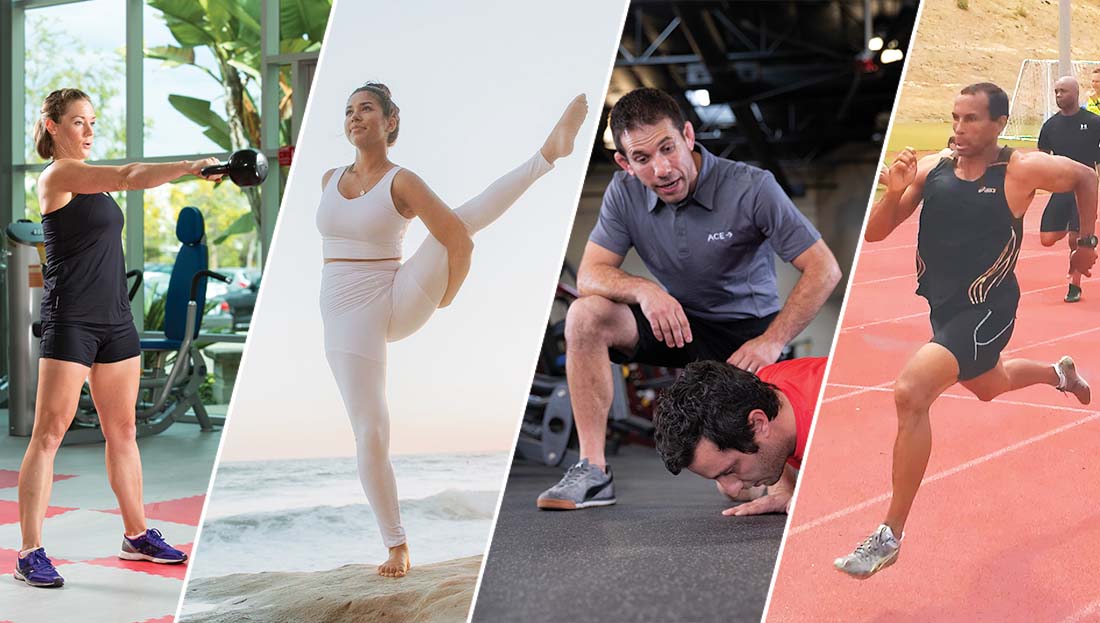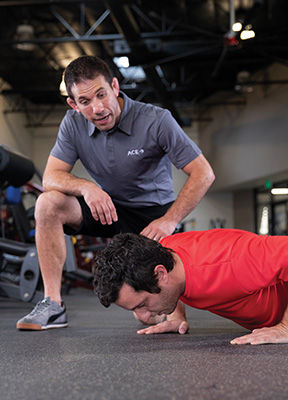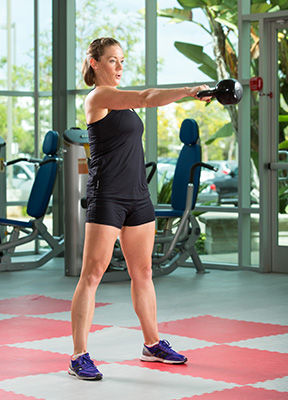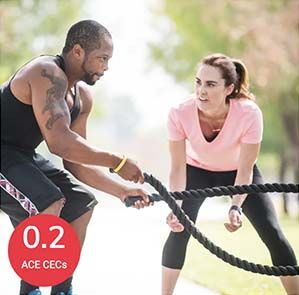
One of the most commonly cited barriers as to why people struggle to adhere to exercise programs is a perceived lack of time. Many people equate exercise with an hour-long trip to the gym multiple times each week, which can feel overwhelming or unrealistic. While those sessions are certainly effective, shorter and more efficient workouts can help clients reach their goals, as well.
Elyse Miller, ACE Certified Personal Trainer and ACE Brand Ambassador, led a recent webinar entitled Programming Short Workouts for Busy Clients, during which she discussed how to properly design short workouts based on your clients’ goals and time constraints. Incorporating shorter workouts can bring about greater consistency, improved adherence and better results, and may be more appealing to busy clients—and who isn’t busy these days?
The Benefits of Short Workouts
The most obvious benefit of shifting from 60-minute workouts to 20-minute workouts, for example, is time-efficiency. Shorter sessions also allow you to program a bit differently. Miller often uses this format to motivate her clients to maximize their results by performing high-intensity workouts like HIIT, AMRAP and EMOM (high-intensity interval training, as many reps as possible, every minute on the minute).
“When it’s a shorter amount of time,” she explains, “they can work more intensely.” Such high-intensity work may not be sustainable during 30-, 45- or 60-minute sessions. These short but intense bouts can elevate their fitness level or athletic ability. One important note from Miller: Never lose sight of the fact that “high-intensity” means something different to each client, so it’s vital that short workouts are just as personalized as your hour-long sessions.
Of course, not every client is looking to maximize the intensity of their physical activity. As you’ll see below, 20-minute workouts can be used to do everything from break up a sedentary workday to focus on a single piece of equipment that delivers results while optimizing efficiency.
Different Delivery Options
For some clients, short workouts can be performed at home to complement their gym-based exercise regimen. For others, they may comprise the entirety of their program. The good news is that there are several ways you can offer short workouts as an option that will not only better serve your busy clients, but also create additional revenue.
Miller does most of her training through an online platform that allows her to record the classes, which her clients can perform on their own schedule. You might also offer these as written workouts as part of a training package that includes both in-person training and at-home workouts.
Perhaps you want to consider offering 20-minute sessions in the gym rather than as something your clients do on their own or online. You might have blocks of time when you lead two to three 20-minute sessions per hour. You may be able to offer a discounted rate to your clients for these shorter sessions while increasing your income. For example, you may charge $60 for a one-hour session, but $25 for 20 minutes, which increases your hourly income to $75.
Finally, you might offer these short workouts as small-group training sessions for clients of a similar skill and fitness level, again increasing your income while maximizing your clients’ benefits and reducing time. Don’t be afraid to be creative when building packages that include a variety of options at different price points. This can be a great way to expand your reach and serve more clients.
Programming Considerations
When discussing the differences between programming long and short workouts, Miller says, “A big thing is the warm-up and cool-down, just making them more intentional.” When you only have 20 minutes to work with, you don’t have time for a distinct five-minute warm-up and five-minute cool-down. To overcome this, Miller recommends incorporating them into the first and last circuit, respectively.
For example, you might perform a movement more slowly or with less intensity during the first circuit and then speed up and add intensity later on. Or, you may opt to begin the first circuit with two minutes of marching in place, adding high knees and overhead reaches over the course of that duration. Similarly, for the cool-down, you can slow down and reduce the range of motion of movements over the course of the last circuit. Miller also likes to end her short sessions with a series of three or four deep breaths to bring the heart rate down.
Miller also highlights the fact that efficiency is vital when programming a short workout, as you don’t have time to waste. It’s important to cut down travel time between exercises and to simplify transitions between types of equipment. Limit yourself to one or two pieces of equipment, if possible, so that your client is not spending time moving around the gym.
Short Workouts Samples
In this section, four ACE employees share 20-minute workouts that accomplish different goals and are suitable for various types of clients. Keep in mind that these are samples only and may not be appropriate for all clients; be sure to modify as necessary to align with each client’s goals, health and fitness level, and preferred exercise modalities.

AMRAP
Chris Gagliardi, MS, ACE Scientific Education Content Manager
An AMRAP workout centers on performing “as many rounds as possible” in a given amount of time, in this case 20 minutes. Perform the exercises in the order listed and for the specified number of repetitions. Keep recovery periods to a minimum but allow enough time so that exercises can be completed with proper posture and movement technique. Completing all the exercises for the specified number of repetitions counts as one round. This workout can be completed twice per week as part of a plan to meet the recommendations for muscle-strengthening activity and to build general muscular fitness.
Keep track of how many rounds you can complete initially in the 20-minute time frame and track your progress over time. If you can complete four rounds in 20 minutes, consider incorporating additional exercises, adding external resistance, adjusting the number of repetitions or picking new exercises to plug into the above template.

Kettlebell Circuit
Jacque Crockford, DHSc, ACE Senior Project Manager
This is an advanced kettlebell circuit. A client may choose to use one weight for the entire circuit, or a variety of weights may be used for the different exercises. The number of sets and time for repetitions may also be changed to suit varying fitness levels. This workout is great for clients with goals of improved strength, endurance and mobility. Have the client perform circuit 1 three times, rest for 60 to 120 seconds, then perform circuit 2 for three rounds.

Yoga Workout to Break Up Your Workday
Araceli De Leon, MS, RYT 500, ACE Business and Career Content Manager
The following workout is designed to counteract the negative effects of prolonged sitting. Incorporating these poses into your daily routine can also promote better posture, flexibility and overall well-being. Remember to listen to your body and breathe comfortably.

Speed Workout for Athletes
Anthony Wall, MS, ACE Senior Director, Global Business Development
Speed is required in almost all sports. Whether it is making a break to accelerate away from an opponent, closing in for a tackle or chasing the ball, speed is always a factor. Developing speed is a skill that requires focus and dedication. This track-based session should give you a taste of what a speed-inspired workout entails. The workout intentionally does not involve 100% intensity. Sprinting at full speed takes time and a progressive approach. This workout is one your clients can enjoy when they have a limited amount of time available.
If they have time for a longer session, increase the warm-up with more drills or jogging. The recovery phase of the session should include a cool-down and stretch, which is not included in this 20-minute workout but is a vital element of an athlete’s training. It can be as simple as three to five minutes of jogging or walking and stretches that target the quadriceps, hamstrings, hips, low back and calves.
|
Section
|
Activity
|
Repetitions
|
Location
|
Description
|
|
Warm-up
|
Jog 3–5 minutes
|
|
Grass infield or track
|
Use this time to think about what you want to pay attention to during the session. For example, maybe the focus is the set-up of the acceleration drills, or running with relaxed form in the final few reps. This is your time to make the mental shift from what you were doing before the session to the session itself.
|
|
Warm-up
|
Jog high knees
|
3 x 15 meters – walk back recovery
|
Grass infield or track
|
This drill helps develop balance and coordination. Keep the upper body upright while using an exaggerated jogging movement. Knees come up to waist height. The movement is rhythmic. Keep on your toes.
|
|
Warm-up
|
Step high knees
|
3 x 15 meters – walk back recovery
|
Grass infield or track
|
This drill is a foundational movement for leg speed drills. This can be done at a walking or jogging pace depending upon desired intensity. Perform a normal walking movement that drives the knee up to waist height. As the movement progresses, think about the foot tapping down on the ground. Stay upright throughout the movement.
|
|
Warm-up
|
Ankle drills
|
3 x 15 meters – walk back recovery
|
Grass infield or track
|
This drill helps develop dynamic strength and movement in the lower leg and ankle. Walk forward using an exaggerated foot/ankle movement. The steps are short and the movements quick. Think of a shuffle movement.
|
|
Warm-up
|
Easy run – 50 %
|
3 x 30 meters – walk back recovery
|
Track
|
These runs are used to get the body moving, focusing on easy acceleration.
|
|
Warm-up
|
Easy run – 60 %
|
4 x 30 meters – walk back recovery
|
Track
|
Same focus, but with a bit more intensity. Should still be very relaxed and not feel as if there is any push needed.
|
|
Workout
|
Acceleration to 80%
|
2 x 50 meters – Slow walk back recovery
|
Track
|
Using the first 30 meters to increase to 80% speed and then maintain that speed for the last 20 meters.
|
|
Workout
|
Acceleration to 70%
|
2 x 30 meters – Slow walk back recovery
|
Track
|
Use these runs to accelerate with a relaxed movement and prepare for the final set of runs.
|
|
Workout
|
Intensity – 80%
|
2 x 60 meters – Slow walk back recovery
|
Track
|
Think faster acceleration to 80%, then maintain through the final meters.
|
Final Thoughts
Short, efficient workouts can serve a number of purposes for your clients, including improving general fitness, providing a quick mood boost during a hectic day and adding variety to their exercise regimens. And, they offer you an opportunity to not only serve your clients more fully, but also increase your revenue and add variety to your own routine. So, whether your clients want to sneak in a quick yoga flow midday to relax their minds and stretch their bodies or perform a quick HIIT workout on a day they can’t make it to the gym, these workouts can offer an effective solution.
Expand Your Knowledge
Programming Short Workouts for Busy Clients
For clients who prefer shorter daily workouts over lengthy sessions three to four times a week, it is important to understand the most efficient exercises to help them reach their goals. In this course, you’ll learn how to create quick and effective workouts that maximize the power of every minute and every move, as well as how to properly design a weekly, monthly and yearly schedule to keep clients engaged and on track to reach their goals.





 by
by 







